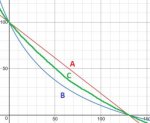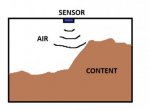First off, apologies for this post as I'm a Math-noob and am failing at figuring this out myself.
For a work-related project I'm working on a device that utilizes ultrasonic sensors to estimate how full (0-100%) a 1.3m container. Initially, I used the following formula (Y: Container full-ness, X: Measured distance (cm) from sensor):
A: y = (130-X)/130 * 100
I quickly found that this led to over-estimations in the data, so I wanted to adjust it. Through trial and error in a plotter I came up with the next formula:
B: y = 12480/(78+X) - 60
While the shape resembles what I want (exponential increase of % as the container fills up more), the "curve" is too strong. Therefore, I'm looking for a graph C, that is based off of graph B, but falls right in between Graph A and B, i.e. it still intersects at 0,100 and 130,0.
I have no clue however what values I should adjust to accomplish this. I've been trying probably for more than an hour now, to no avail. Any help would be greatly appreciated.

For a work-related project I'm working on a device that utilizes ultrasonic sensors to estimate how full (0-100%) a 1.3m container. Initially, I used the following formula (Y: Container full-ness, X: Measured distance (cm) from sensor):
A: y = (130-X)/130 * 100
I quickly found that this led to over-estimations in the data, so I wanted to adjust it. Through trial and error in a plotter I came up with the next formula:
B: y = 12480/(78+X) - 60
While the shape resembles what I want (exponential increase of % as the container fills up more), the "curve" is too strong. Therefore, I'm looking for a graph C, that is based off of graph B, but falls right in between Graph A and B, i.e. it still intersects at 0,100 and 130,0.
I have no clue however what values I should adjust to accomplish this. I've been trying probably for more than an hour now, to no avail. Any help would be greatly appreciated.


